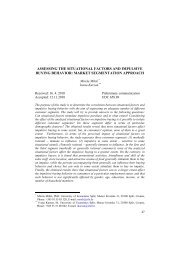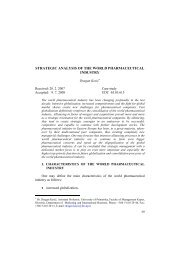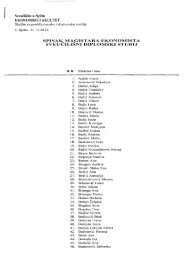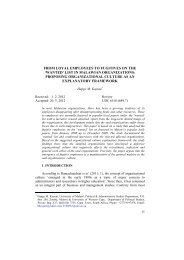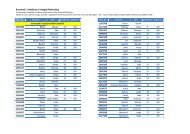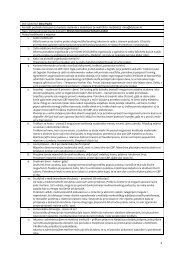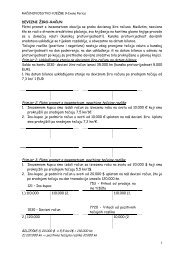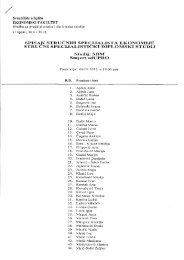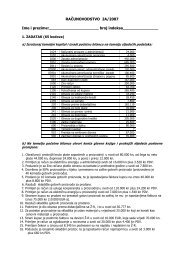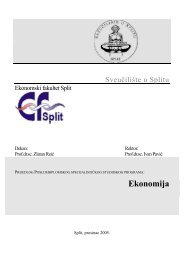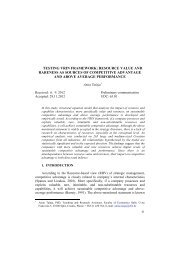REGIONAL TREASURY CENTRES IN SOUTH EAST ASIA – CASE ...
REGIONAL TREASURY CENTRES IN SOUTH EAST ASIA – CASE ...
REGIONAL TREASURY CENTRES IN SOUTH EAST ASIA – CASE ...
Create successful ePaper yourself
Turn your PDF publications into a flip-book with our unique Google optimized e-Paper software.
Management, Vol. 14, 2009, 1, pp. 77-101P. Polak, R. R. Roslan: Regional treasury centres in South East Asia – The case of Brunei…Table 6. Price for foreign outgoing paymentLocation Criterion (4) Brunei Singapore Hong KongPrice for foreign outgoingpaymentBND25 SGD15 HKD116.67Exchange rate (AUD1) 1.1697 1.1697 6.3725Price for foreign outgoingpayment (AUD)21.37 12.82 18.31Table 7 appraises LCn 5, i.e. the price for making urgent foreign outgoingpayments. The average price compared across the three countries shows Bruneioffers the most expensive services at the average rate of AUD 21.40, whileSingapore offers the lowest average rate of AUD 12.82.Table 7. Price of urgent foreign paymentsLocation Criterion (5) Brunei Singapore Hong KongUrgent foreign payments price BND25.03 SGD15 HKD156.67Exchange rate (AUD1) 1.1697 1.1697 6.3725Urgent foreign payments price(AUD)21.40 12.82 24.59Table 8 assesses LCn 6 (withholding tax). The withholding tax of all threecountries were collected and compared. Singapore offers the lowest, whencompared to Brunei, but Hong Kong does not impose withholding tax.However, in certain circumstances, 1.75% of royalties is subjected to tax.Table 8. Withholding taxLocation Criterion (6) Brunei Singapore Hong KongWithholding tax 20% 15% N/ATable 9 shows corporate tax (LCn 7) compared across the three countries.Brunei has corporate tax of 30%, Singapore 18% and Hong Kong the lowestone (17.5%).90
Management, Vol. 14, 2009, 1, pp. 77-101P. Polak, R. R. Roslan: Regional treasury centres in South East Asia – The case of Brunei…Table 9. Corporate taxLocation Criterion (7) Brunei Singapore Hong KongCorporate tax 30% 18% 17.5%Table 10 presents the existing important treasury centres that have alreadybeen located in each of the three countries, which represents the presents LCn 8.There are no RTCs in Brunei, quite a few in Singapore (including those ofmultinationals, such as Nokia, Sony, UPS, Caltex, Ericsson, etc.), as well as afew in Hong Kong, as well (including JP Morgan and P & O Nedlloyd’s).Table 10. Important treasury centresLocation Criterion (8) Brunei Singapore Hong KongNokia, Nissan,JP Morgan, P&OImportant treasury centresnone Sony, UPS,Nedlloyd'sCaltex etcTable 11 presents results related to LCn 9 (reporting requirements tocentral banks/Monetary Authority for banking transactions). Brunei andSingapore offer minimum reporting requirements to the Monetary Authority,while Hong Kong requires gross amount of lending and borrowing reporting(Hong Kong Monetary Authority 2005).Table 11. Reporting requirementsLocation Criterion (9) Brunei Singapore Hong KongOnly certain No capitalReporting requirementsSome controlthreshold. controlsTable 12 assesses the currency environment of each country (LCn 10), interms of the ability of MNCs to make transactions in major foreign currencies,such as USD, EUR, GBP, AUD, etc. Most banks in the three countries offerbanking facilities in the mentioned foreign currencies.Table 12. Currency environmentLocation Criterion (10) Brunei Singapore Hong KongCurrency environmentUSD, EUR,GBP, AUD,JPY etcUSD, EURO,AUD, GBP,JPY etcUSD, EURO,AUD, GBP,JPY etc91
Management, Vol. 14, 2009, 1, pp. 77-101P. Polak, R. R. Roslan: Regional treasury centres in South East Asia – The case of Brunei…Table 13 shows the credit ratings of three countries. Both Singapore andHong Kong hold the A1 business climate and country credit ratings.Table 13. RatingsLocation Criterion (11) Brunei Singapore Hong KongRatings N/A A1 A1The following table summarizes analysis of all the previous locationcriteria.92Table 14. Summary of results (monetary values in Australian dollars – AUD)No.Location Criterion(LCn)Brunei Singapore Hong Kong1 Monthly bank fees 17.67 12.82 5.752 Bank transaction fees 7.12 0.28 8.903Price for foreignincoming payment12.85 8.55 6.544Price for foreignoutgoing payment21.37 12.82 18.315Urgent foreign paymentsfees21.40 12.82 24.596 Withholding tax 20% 15% N/A7 Corporate tax 30% 18% 18%8Important treasurycentresNone Several Several9 Reporting requirements Minimum Minimum Minimum10 Currency environmentUSD, EURO,GBP, AUD, JPYetcUSD, EURO,AUD, GBP, JPYetcUSD, EURO,AUD, GBP, JPYetc11 Ratings N/A A1 A17. DISCUSSION OF QUALITATIVE AND QUANTITATIVE LCThis paper examines whether Brunei Darussalam has the opportunitiesand/or resources to become the next leading location for RTCs in Asia. Byusing a similar method of finding suitable location for a RTC - Simkova (2005,cited in Polak et al. 2007), this study produces results similar to Simkova(2005). The main functions of treasury management, i.e. cash management(Mulligan, 2001), especially making foreign payments, which are in the focus ofthe study performed by Simkova (2005), are also analyzed in this paper.
Management, Vol. 14, 2009, 1, pp. 77-101P. Polak, R. R. Roslan: Regional treasury centres in South East Asia – The case of Brunei…Discussion of each result of LC found is focused on whether Brunei cancompete with the other two countries, which are currently the leading locationsfor RTCs. Results of LC with quantitative data (LCn 1 – LCn 7) are discussedfirst, followed by the analysis of criteria LCn 8 to LCn 11 (based on qualitativedata).Table 15. Assessment of quantitative LCNo.Location Criterion(LCn)Brunei Singapore Hong Kong1 Monthly bank fees Highest Middle Lowest2 Bank transaction fees Middle Lowest Highest3Price for foreignincoming paymentHighest Middle Lowest4Price for foreignoutgoing paymentHighest Lowest Middle5Urgent foreign paymentspriceMiddle Lowest Highest6 Withholding tax Highest Middle Lowest7 Corporate tax Highest Middle Lowest8Important treasurycentresNone Existing RTCs Existing RTCs9 Reporting requirements Minimal Minimal Minimal10 Currency environment 1 bank 3 banks 3 banks11 Ratings N/A Best BestNotes: Highest – LCn with the highest figure, Middle – LCn with not the highest or the lowestfigure, Lowest – LCn with the lowest figure.7.1. Discussion of quantitative data results (LCn 1 – LCn 7)Table 16 represents assessment of the three countries, regarding theunfavorable LC values. For LCn 1 – LCn 7, the target is to minimize the highfigures for each country. In order to assess competitiveness of Brunei’s currentcondition for hosting RTC, it is easily demonstrated that the country currentlyholds 71.4% of the unfavorable ranks significant for a suitable location of aRTC. Hong Kong has 28.6% of such LC ranks, while Singapore has none.93
Management, Vol. 14, 2009, 1, pp. 77-101P. Polak, R. R. Roslan: Regional treasury centres in South East Asia – The case of Brunei…Table 16. Countries with unfavourable LC valuesNo. Location Criterion (LC) Brunei Singapore Hong Kong1 Monthly bank fees Highest2 Bank transaction fees Highest3Price for foreignincoming paymentHighest4Price for foreignoutgoing paymentHighest5Urgent foreign paymentspriceHighest6 Withholding tax Highest7 Corporate tax HighestIt can be concluded that Brunei offers the most expensive banking servicerelated to RTC functions and higher percentage tax for MNCs, compared to thebanks in Singapore and Hong Kong.Hong Kong and Singapore have 57.1% and 48.9% of the most favorablequantitative LC ranks (respectively), while Brunei has none (see Table 17).Singapore and Hong Kong have the lowest average fees for banking service andlow percentage tax. At the other hand, Brunei neither offers the affordablebanking service, nor the tax rate suitable for RTCs.Table 17. Countries with favourable LC valuesNo. Location Criterion (LC) Brunei Singapore Hong Kong1 Monthly bank fees Lowest2 Bank transaction fees Lowest3Price for foreignincoming paymentLowest4Price for foreignoutgoing paymentLowest5Urgent foreign paymentspriceLowest6 Withholding tax Lowest7 Corporate tax Lowest94
Management, Vol. 14, 2009, 1, pp. 77-101P. Polak, R. R. Roslan: Regional treasury centres in South East Asia – The case of Brunei…7.2. Discussion of qualitative data results (LCn 8 – LCn 11)LCn 8 - Important treasury centresTable 18 shows the assessment for qualitative LC. For LCn 8, Brunei cannot be rated, as there are no RTCs present, compared to those that have been setup in Singapore and Hong Kong. There are currently about 150 RTC operationsin Singapore, according to recent study by PricewaterhouseCoopers (Giumarra2001), which is the largest number of RTCs in Asia Pacific (Kini, 2007). Withalready existing RTCs, Singapore and Hong Kong both are in an already goodposition for future RTCs to be located there by prospective MNCs. Theavailability of other RTCs in the region would show that the region already hasthe treasury function support needed by this entity.Table 18. Assessment of quantitative LCNo.Location Criterion(LCn)Brunei Singapore Hong Kong8Important treasurycentresZero One One9 Reporting requirements Minimum Minimum Minimum10 Currency environment 1 bank 3 banks 3 banks11 Ratings None Best BestLCn 9 - Reporting requirementsOut of the three countries assessed for this LC, Hong Kong and Bruneishare a fair reporting requirement to the central bank/Monetary Authority.While, in Hong Kong, banks are required to report gross lending and borrowing,any amount of fund transfer reaching a certain threshold would need to bereported to the Ministry of Finance, i.e. Brunei Monetary Authority. Accordingto the data collected, Singapore has the least reporting requirements, whichmakes it a more favorable destination for RTCs.LCn 10 - Currency EnvironmentOut of the three banks assessed in Brunei, only one offers foreign currencyaccount and services, including important currencies, such as the USD, EURO,GBP, AUD, CAD, JPY and many more. The other two international banks donot provide services with these currencies, while all three banks, from bothSingapore and Hong Kong, provide both services in the previously mentioned95
Management, Vol. 14, 2009, 1, pp. 77-101P. Polak, R. R. Roslan: Regional treasury centres in South East Asia – The case of Brunei…foreign currencies, as well as in many others. The ability to conduct transactionsin foreign currencies is a crucial part of a RTC function. As the RTCs deal withcash management, especially with the cross-border transfers, the ability toprovide instant conversion of currencies serves well in making a locationsuitable to accommodate a RTC.96LCn 11 – RatingsRatings offered by Coface consider a country’s overall liquidity andsolvency (i.e. its “business climate”). Singapore and Hong Kong are both giventhe best rating of A1 for their business climate, whereas it is difficult to findonline ratings for Brunei.8. DISCUSSION AND RECOMMENDATIONS8.1. DiscussionFrom the results, it can be clearly concluded that Brunei Darussalam hasmore expensive banking service fees and charges and higher percentage taximposed on company profits by the local authority, compared to Singapore andHong Kong. This may be the first obvious sign indicating Brunei’s lower levelof competitiveness, not only in terms of attracting RTCs, but also in attractingMNCs. Major companies deal with major movements of funds, in amounts ofmillions, or even billions. If Brunei falls short in competing with the othercountries, they will become the preferred location for regional headquarters orfinance offices to be set up by these major companies (Economist IntelligenceUnit Limited, 2000). Competing closely to Singapore and Hong Kong, as thesetwo countries are Asia’s international financial centres (Levieux, 2007), isimportant, if Brunei are to follow in their footsteps.The averaged price for making overseas payments provided by the banks inBrunei is higher than those offered in Singapore and Hong Kong. MNCsoriginating from other countries will not benefit from cost savings by locatingtheir regional operations in Brunei. Profits will not be taxed as much in HongKong or Singapore compared to Brunei, which has the highest corporate taximposed on profits. Having the highest percentage of withholding tax alsoreduces Brunei’s competitiveness in attracting RTCs, as these entities areprimarily tax driven (Anwar 1999, Zink 1995, Murphy 2000a, Casalino 2001,Giegerich et al 2002, Simkova 2005, Polak 2007). A benign tax system is thecrucial aspect to attracting RTCs (Mulligan, 2001).
Management, Vol. 14, 2009, 1, pp. 77-101P. Polak, R. R. Roslan: Regional treasury centres in South East Asia – The case of Brunei…In terms of existing RTCs in the region, Brunei currently has none. Theclosest RTC is in Labuan - an island eight kilometer off the coast of Borneo,where Brunei Darussalam is located (Wikipedia, 2008). The RTC is the regionalfinance office with treasury functions for Shell Malaysia. Due to this,considering Brunei as a prospective location for an RTC may not be viable. Atthe other hand, Singapore is the fourth largest trader in derivatives and the ninthlargest offshore lender, which makes it an attractive location for setting up aRTC, with already approximately 150 existing RTCs (Giumarra, 2001). HongKong is the next favorite location for regional headquarters of MNCs and RTCsin Asia (Business Asia, 2000, Levieux, 2007). Although the actual number ofRTCs that have been established in Hong Kong is not available, it can bedefinitely considered as the major rival of Singapore.Flexible regulation is also a factor to consider when considering a locationfor a RTC (Zink, 1995, Anwar, 1999, Geigerich, 2002). Although Bruneicurrently does not strictly regulate transfer of funds between financialinstitutions, this is also not the casefor Singapore and Hong Kong. The facilityfor foreign currency transaction is already available in Brunei, although it is notas developed compared to Singapore and Hong Kong. Some banks in Bruneioffer accounts and services in most important foreign currencies, i.e. USD,EURO, GBP, AUD, JPY, SGD, and a few more. This shows that Brunei hassome potential to start off the improvements needed to improve its position toattract RTCs or even regional headquarters of MNCs.At the time of writing, Singapore and Hong Kong had the best Cofaceratings for the country's business climate. Other than having a good businessenvironment, Singapore and Hong Kong are considered by this rating companyto have “available and reliable corporate financial information together withvery good institutional quality”. Information regarding Brunei should be alsoeasily available to potential overseas investors, which is not the case now.8.2. RecommendationsIn order to compete with Singapore and Hong Kong, it is important forBrunei to remain vigilant in terms of regulations significant for potentialoverseas investors. According to this study, reassessing banking facility chargesfor businesses/corporations, especially the international ones, would be a fairstart. Next, Brunei’s current taxation regulations, imposed on any types ofcompanies both local and international, should be examined. Singapore and97
Management, Vol. 14, 2009, 1, pp. 77-101P. Polak, R. R. Roslan: Regional treasury centres in South East Asia – The case of Brunei…Hong Kong are in a better position in terms of attracting RTCs or regionalheadquarters of MNCs, as their tax is lower. Nokia chose Singapore over HongKong, Malaysia and Australia due to unattractive tax regimes offered by theother three countries (Blair, 1999). Tax reforms will certainly attract foreigninvestors into Brunei, as Singapore attracted over 3600 regional headquarters in2003 (up from 49 in 1993) through tax concessions (Zilva, 2004). As local taxregulation is the primary factor when considering location for RTC (Zink, 1995,Anwar, 1999, Casalino, 2001, Geigerich, 2002, Simkova, 2005, Polak, 2007), itshould be regulated tax system according to the Singapore and Hong Kongbenchmarks.Increasing the number of students with a major in finance at universitylevel could also benefit Brunei in the long term, as RTCs require trainedspecialists in the area finance and are ideally located in areas which haveexperts with treasury related competences (Murphy, 2000a, 2000b, Casalino,2001, Geigerich, 2002).989. CONCLUSIONThere are many more factors to consider when considering a location forRTCs. Simkova (2005, cited in Polak et al., 2007) provides a full description ofthe specific needs of a holding company in Czech Republic and formulates theLC (utilized in this study) to investigate the conditions of European for thelocation of this holding company’s RTC. This study uses the similarmethodology and reaches the conclusion that Brunei does not have the requiredresources or abilities to efficiently host an RTC, when compared to Singaporeand Hong Kong. However, this conclusion is incomplete, because LC utilized inthis study are merely one aspect of examining a potential RTC location. It is oneof the methods how to assess such a location and there may be additionalpossible variables, which need to be considered. These include the languagebarriers, availability of expertise and outsourcing options, access to keyfinancial markets and banking centres, stability of communication networks,time zone, notional pooling, cash concentration and many more (Zink 1995,Anwar, 1999, Murphy 2000a, 2000b, Casalino, 2001, Giegerich, 2002,Simkova, 2005).All the other potential LC need to be investigated, as well to completelyindicate if a location, such as Brunei Darussalam, can successfully host aregional treasury centre. This is the limitation of this study, which remains thefuture research task. Another limitation is related to establishing the fact (either
Management, Vol. 14, 2009, 1, pp. 77-101P. Polak, R. R. Roslan: Regional treasury centres in South East Asia – The case of Brunei…statistically, or mathematically) that more favorable LC (for example, that ofSingapore and Hong Kong) do result in attraction of RTCs and improvement oftheir operations in terms of cost efficiencies (minimal banking costs and lowtax), minimal restrictions for fund transfers between the entities involved(banks, RTCs and companies).REFERENCES1. Anwar, T., 1999, Conducting a Feasibility Study for a Regional Centre(RTC), GTnews: The treasury & finance network, viewed 23 June 2008,http://www.gtnews.com/article/1146.cfm.2. Asianbanks.net, 2004, Asian Bank Rankings, AsianBanks.net, viewed 16July 2008, http://asianbanks.net/HTML/Rankings/rank-asia.htm.3. Blair, N., 1999, “Corporate Treasury in Singapore”, The Treasurer, viewed26 March 2008, http://www.gtnews.com/article/1420.cfm4. Casalino, M., 2001, “Europe: Sitting a Treasury Center”, GTnews: Thetreasury and finance network, viewed 1 April 2008,http://www.gtnews.com/article/3674.cfm5. Central Intelligence Agency, 2008, “Brunei”, The World Fact Book, viewed22 March 2008, https://www.cia.gov/library/publications/the-worldfactbook/geos/bx.html.6. Chang, R. W., (not dated), The UPS model for a Shared Service Centre,Treasury Management International, viewed 19 July 2008,http://www.treasury-management.com/showarticle.php?article=669&pubid=4&issueid=737. Coface, (not dated), Coface launches a new business climate rating, viewed4 July 2008, http://www.swinburne.edu.au/lib/researchhelp/harvard_system.htm.8. De Zilva, A., 2004, Tax Concessions for Regional Operating HeadquarterCompanies: A Comparative Study of Singapore, Malaysia, Thailand andAustralia, Australian Journal of Asian law, Vol. 6, Issue 1, viewed 3 June2008,http://search.informit.com.au/documentSummary;dn=580640057561194;res=E-LIBRARY.9. Giegerich, U., Lissis, A., 2002, “Implementing a Treasury Center inSwitzerland”, GT news: The treasury and finance network, viewed1 April2008, http://www.gtnews.com/article/4536.cfm10. Giumarra, R., 2001, Cash Management in Singapore, Gtnews.com: thetreasury & finance network, viewed 25 April 2008,http://www.gtnews.com/article/2865.cfm99
Management, Vol. 14, 2009, 1, pp. 77-101P. Polak, R. R. Roslan: Regional treasury centres in South East Asia – The case of Brunei…11. Horton, A. V. M, 2004, Window-Dressing an Islamizing Sultanate. AsianSurvey, Volume 45, Number 1 (January/February 2005), pp. 180-18512. Kini, M 2007, Cash Management in Singapore, GTnews.com: the treasury& finance network, viewed 23 May 2008, http://www.gtnews.com/article/6831.cfm13. Leow, E, 2005, “Singapore’s 2005 Budget: Tax Implications for Multi-Nationals Companies, Intertax, Vol. 33, Issue 6/7, pp. 301-30214. Levieux, S., 2007, “Where Should You Locate You Regional TreasuryCentre?” HSBC’s Guide to Cash and Treasury Management in Asia Pacific2007, pp. 50-54, viewed 27 March 2008, http://www.hsbcnet.com/transaction/attachments/APH/pdf/03_cmp_where.pdf15. Mulligan, E., 2001, “Treasury Management Organisation: An examinationof Centralised versus Decentralised Approaches”, Irish Journal ofManagement, Vol. 22, Issue 116. Murphy, A., 2000(a), “Solving the problems of globalization”, TreasuryManagement International, pp. 49-54, viewed 1 April 2008,http://www.fti.ie/documents/Solving%20the%20problems%20of%20Globalisation.pdf17. Murphy, A., 2000(b), “Non-tax factors in treasury centre decisions”, TheTreasurer, pp. 56-58, viewed 2 April 2008, http://www.treasurers.org/purchase/customcf/download.cfm?resid=51918. Polak, P., Kocurek, K., 2007, “Dulcius Ex Asperis – How cash poolingworks in the Czech Republic”, Management, Vol. 12, No. 2, pp. 85-95.Viewed 18 March 2008, http://www.efst.hr/management/Vol12No2-2007/6-polak-kocurek.doc19. Potty, B. P., Sarraf, M., 2004, “Treasury Organisation: Picking the RightModel”, HSBC’s Guide to Cash and treasury Management in Asia Pacific2004, pp. 139-143, viewed 10 April 2008, http://www.infosys.com/Finacle/pdf/Tech_HSBC4.pdf20. Watanabe, R., 1998, “Developing Taiwan into a Regional Finance andOperations Centre: a Taxation Perspective, Revenue Law Journal, vol.8,issue 1, article 5, pp. viewed 11 April 2008, http://epublications.bond.edu.au/cgi/viewcontent.cgi?article=1093&context=rlj21. Wong, P., 2007, “The reinvention of the New Asia”, HSBC’s Guide to Cashand Treasury Management in Asia Pacific 2007, pp. 43-47, viewed 28March 2008, http://www.hsbcnet.com/transaction/attachments/APH/pdf/01_introduction.pdf22. Zink, W. J., Griffiths, S. H., 1995 "U.S. and foreign tax implications ofinternational treasury centers." Corporate Cashflow Magazine, Vol. 33, No.3100
102



